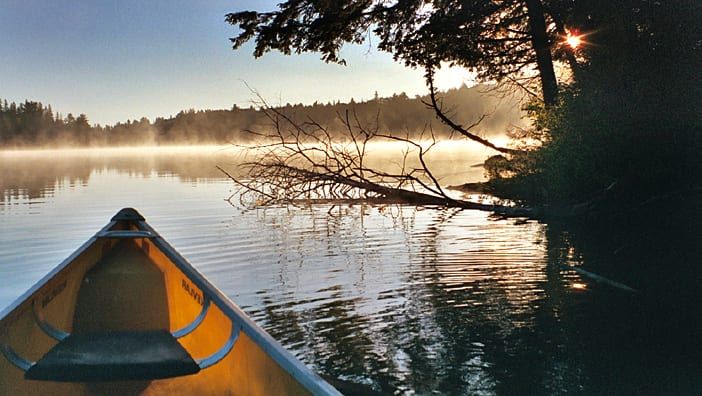Algonquin Provincial Park is nestled within Ontario’s Canadian Shield, approximately 300 km from Toronto and 275 km from Ottawa. Spanning over 7,653 square kilometers, this iconic park offers a profound glimpse into the country’s ecological diversity and cultural legacy. When exploring Algonquin Park, you’re traversing through the pages of time itself!
As an Ontario cottage rental agency we know that many of our guests plan their visits around the Park given how many great things there are to do and the many great activities, whether hiking, fishing, camping or biking. These guests will often ask us for assistance in their vacation planning. You’ll find many Muskoka cottage rentals within an hour of the Park. If you prefer the Haliburton Ontario area, many Haliburton cottage rentals are also close enough to allow a day trip to the Park!
How to Get to Algonquin Provincial Park, Ontario
The Park is about a 3 hours’ drive from Toronto, and just over 3 hours from Ottawa. Navigating to the Park from Toronto begins with a drive north on Highway 400. As you travel further north, you’ll see the landscape start to change markedly, with the appearance of the more rugged, rocky hills. These rocky hills are actually part of the Canadian Shield rock, which was formed over 2.5 billion years ago! They provide beautiful scenery and if you happen to be visiting in the Fall you will be mesmerized on the drive up by the changing colours on the trees.
Just past Barrie, continue heading north on Highway 11 all the way to Huntsville, Ontario. From there, head east on Highway 60 right into the western entrance of the Park, just east of Dwight.
From Ottawa, take Highway 417 west to Renfrew, and then Highway 60 right into the Park’s eastern entrance.
It is possible to simply drive right through the Park, viewing wildlife from your vehicle; but we highly recommend that you stop and take your time. There are multiple Information Centres that you can stop at to pick up a map and get ideas for the best areas to explore depending on what activities your group is most excited to try!
The History and Significance of Algonquin Provincial Park
Algonquin Park was initially used by loggers from the Ottawa Valley in the 1800s. They came further north looking for new sources of great White Pine trees, which were in high demand given they were the key component in homesteads for the growing Ontario settlements.
The loggers lived in remote logging camps. The timber was cut and squared there throughout the winter. Once spring arrived, it was sent down the fast-moving, high rivers to the Ottawa River in the spring. Fun fact – many logs likely still lie at the bottom of the river as not all of them made it to their end destination.
For more information visit the Algonquin Logging Museum near the East Gate.
First established in 1893 as a National Park, Algonquin Provincial Park became Ontario’s first provincial park in 1913, and it played a pivotal role in pioneering the provincial park system that we now have in Canada. Originally the park was created to protect the wildlife. To protect the headwaters of five major rivers, agriculture is no longer allowed within the boundaries of the Park.
Although extraction is still performed, the main focus of the park has shifted over the years. The Park is now considered a recreational and educational resource, as well as providing wildlife protection.
Algonquin Park’s natural, rugged, landscape has inspired many artists and writers. The most well-known of these were the Group of Seven. This was a famous collective of Canadian landscape painters inspired by the park’s rugged beauty. Many of their paintings were based on landscape views of Algonquin Park.
Things to Know before you Head to the Park
It’s essential that you prepare properly in order to experience the vast wilderness areas safely! Given the park’s vastness, it’s easy to underestimate the sheer size and scope of the wilderness within. Ensure that you have detailed maps of the area and your phone is fully charged. The park also has detailed markings on its trails to make it easier for hikers to properly navigate the various trails.
If you’re camping in the backcountry overnight, be sure to check the Park’s regulations and guidelines. Your group must possess a valid Interior Camping Permit to venture into the backcountry. When camping it’s essential to store food securely to prevent attracting unwanted wildlife to your campsite.
Be sure to plan your hike to arrive back at your vehicle at least a half hour before sunset. Darkness comes quickly in the woods, and trails can be very difficult to navigate in the dark.
It’s important to note that trail conditions can change fairly quickly. Algonquin Park tends to have colder nights even during the summer. Some trails may become unsafe during rain or snow, and can become difficult to navigate even for experienced hikers.
While not as essential, bug spray is strongly recommended during the warmer months. You will have a much more pleasant experience! In the spring, blackfly season is something to consider. These pests typically emerge in the early spring and last until June. Their presence generally depends on how hot the weather is. As soon as it’s reliably hot, they fade away. Unfortunately, mosquitoes and other bugs then emerge, and can be a nuisance throughout the summer!
Algonquin Provincial Park Activities | Camping | Hiking| Canoeing | Boating | Fishing | Birdwatching
Park activities are possible throughout the year. Popular activities include camping, hiking, canoeing, boating, fishing, and birdwatching. Of course, wildlife viewing is also a popular activity.
Camping Options at Algonquin Provincial Park
Camping is one of Algonquin Park visitor’s most popular activities, and spots are grouped into two main categories based upon the type of access you’d like, each with a designated beach in one of the clean, clear Algonquin Park lakes. With over 1,200 campsites, the park caters to both camping newbies and well-experienced backcountry campers.
Please note that camping in the Park is extremely popular, so reservations are strongly recommended, and may be made up to 5 months in advance through Ontario Parks. If you don’t have your own equipment, there are businesses within and around the Park that will supply them for you.
Drive in Camping at Algonquin Provincial Park
There are no fewer than 12 different developed campgrounds within the park that are reachable by car, with options of tent, RV, or yurt rental. Facilities vary from site to site, and may include electrical sites, flush toilets, hot and cold running water, radio free and dog free campsites, laundry facilities, beaches, and more.
Backcountry Camping at Algonquin Provincial Park
As the name would suggest, these sites are not possible to reach by road, but there are two categories within this section – ones that you reach by hiking, and ones that are accessed by paddling. If you prefer slightly less rustic accommodations, ranger cabins are available from spring to fall at various backcountry campsites, and may be rented in advance of your trip.
Backpacking Trail Camping at Algonquin Provincial Park
There are three overnight backpacking trails to choose from, and all are rated as difficult, with steep climbs, side slopes, and sharp turns. Each of these trails have parking and bathrooms, and of course lakes and rivers to explore, but other features vary by trail.
The overnight backpacking trails include the Eastern Pines Backpacking Trail, a trail with loops of 6 – 15 kilometres in length. This trail is accessed from the Grand Lake – Achray access point. Features include scenic lookouts, a glacial boulder garden, and High Falls on the Barron River. Please note that this trail is open only from spring to fall.
The remaining two trails are open year round. The Highland Backpacking Trail offers loops of 19 and 35 kilometres in length, and can be accessed from the Highland Backpacking Trailhead off Highway 60 at kilometre 29.7. There are scenic lookouts along the way.
The Western Uplands trail has loops of 32 to 88 kilometres in length, and can be accessed from the Western Uplands Backpacking Trailhead/Oxtongue River Picnic Ground or the Rain Lake access point. Trail features include a picnic ground at the trailhead, glacial boulders, scenic lookouts, and a ranger cabin that can be rented if you prefer less rustic accommodations!
Paddle-in Campsites at Algonquin Provincial Park
Paddle-in campsites are of course campsites that are reached only by boat (generally canoe or kayak, as most lakes and rivers are not motor-boat friendly).
There are two options for paddle in campsites. Canisbay Lake is ringed with drive-in campsites, but there is also a paddle-in camping option on the southern shore of the lake, open from mid May to mid October. Crotch Lake is the other paddle in option, accessed via the Shall Lake access point.
Hiking Trails in Algonquin Provincial Park
Algonquin Provincial Park has some of the best hiking trails in Canada! There are 21 different hiking trails within the park, ranging in length, difficulty, and terrain, some of which are loops and others in-and-out linear hiking.
A few of the easier trails are The Spruce Bog Boardwalk, a 1.5 km loop trail that’s accessible, perfect for beginners, young children, and anyone with mobility challenges. There’s a flat pathway and a boardwalk from which to view the spruce bog. This trail is great for birdwatching too! If you wish to see wildlife (well, beavers at least), there’s the Beaver Pond Trail, a 2 km looped trail with information on beavers.
Another trail that will appeal to children and history buffs is the Algonquin Logging Museum Trail, a short 1.3km trail with exhibits summarizing the logging history of the Algonquin Park area. It also features a re-created camboose camp (an old logging camp), and a steam-powered amphibious tug.
For intermediate hikers, try the Whiskey Rapids Trail, just a short distance from the western entrance to the park. It’s a just over 2 km long loop that leads to the named Whiskey Rapids, with amazing water views of the rapids and the Oxtongue River.
For incredible lookout views, Centennial Ridge Trail is considered a strenuous trail, but great if you’re fit enough and up for it! It’s a 10.4 km loop trail with views over two high ridges over the park.
More moderate lookout trails are The Track and Tower Trail, a 7.5 km loop with incredible views of the park over Cache Lake, and the Barron Canyon Trail, which leads to, and runs along the north rim of, the spectacular 100m deep Barron Canyon, with stops along the way that explain the formation and history of the canyon. Please use caution on that trail, as it goes along an unfenced cliff, so keep children close by and pets on a leash at all times.
The Brent Crater Trail is also for the more adventurous hiker, just 2 km long, with considered strenuous. The Brent Crater was formed by a meteorite strike thousands of years ago. From an observation tower overlooking the crater the trail descends to the crater floor before heading back to the starting point in a loop. There are six interpretive stops that relate some of the geological and historical significance of the crater. The trail is accessed from the Brent Campground.
Canoeing in Alongquin Provincial Park

Algonquin Provincial Park’s lakes and rivers are the headwaters of six major rivers that flow to Georgian Bay and the St. Lawrence River. Algonquin Park is, without doubt, a paddler’s Eden. Its vast network of over 2,100 km of canoe water routes ensures that every journey on water is unique.
A detailed map-brochure, Canoe Routes of Algonquin Park, can be obtained, and is recommended that you purchase it, as it shows the entire park network of canoe routes, portages, and backcountry campsites, with detailed directions for 29 different access points and information on planning your canoe trip. The Park is even popular for whitewater canoeing and kayaking along some of the waterways.
Boating at Algonquin Provincial Park, Ontario
While motorboats are not permitted on most lakes in the Park, there are exceptions, and the choices vary depending on the horsepower of your boat. Galeairy and Opeongo Lakes both permit motor boats without limitations, but there are a number of other lakes that permit smaller horsepower motorboats. For a full list of what boats are permitted on which lakes, see the Algonquin Provincial Park website.
Fishing in Algonquin Provincial Park
The park’s waters are teeming with aquatic life, and Algonquin Provincial Park has a reputation for some of the best trout fishing in Canada. More than 230 lakes have native Brook Trout and 149 have Lake Trout, continuing to yield good fishing thanks to the Park’s policy of wise conservation.
Many of the lakes along the highway are stocked with Splake (which is a hybrid of Brook and Lake trout) and the fishing is outstanding! Spring is the best season to fish for trout, and summer is great for Smallmouth Bass. During the week of Ontario’s license free fishing weekend in July, Algonquin Park holds a Family Fishing Weekend at Whitefish Lake, offering boats and equipment, prizes, and even a free fish and chips lunch!
If it’s pike you’re after, there are options for that in lakes that are accessible through the Shall Lake Access Point.
Birding/Birdwatching at Algonquin Provincial Park
Algonquin Provincial Park has 272 recorded species of bird, but most of these are seasonal residents, flying south for the winter months. Only a few types of birds reside in the Park year round, and these birds face many challenges in order to survive the harsh winter.
One of these birds is the Gray Jay, and more than 30 years of research has been done on this bird, revealing the unique strategies it has evolved to survive winter in Algonquin Park.
Many southern and overseas birders make special trips to Algonquin just to see northern specialties including the Gray Jay and the Spruce Grouse, not to mention the rich variety of warblers or Algonquin’s most famous bird of all—the Common Loon, with their haunting soft, short hooting calls. Loons typically use this sound to figure out their mate or chick’s location in relation to them. Once heard, we feel you’ll agree that it’s the quintessential sound that exemplifies the peaceful solitude of Ontario’s cottage country.
What Wildlife Can You Expect to See at Algonquin Provincial Park?
Algonquin is a living tapestry of wildlife, with over 55 species of mammal calling the Park home, including black bears, whitetail deer, wolves, beaver, and many people hope to catch a glimpse of some while they’re visiting the Park.
It’s actually the best place in Ontario to see Moose, which can sometimes even be seen by the side of the road if you’re lucky. In particular, Moose are fairly active in the fall (which is rutting season) and can be frequently seen along the side of Highway 60. If you’re driving through the park and see cars pulled over at the side of highway, pull over and watch!
You may be able to spot black bears and deer; however if they hear you coming they’ll likely run away, as they prefer to avoid people, which is great to know – as most people would be equally afraid of meeting a bear up close and personal! If you do happen to see a bear cub, use extra caution and back away, as the mother bear is surely nearby, and will be very protective.
In addition to the large mammals people tend to want to spot, there are 31 different species of reptiles and amphibians in Algonquin Provincial Park as well, including five types of turtles, and nine species of snakes (don’t worry – none are venomous!).
For the best wildlife spotting, the best time is early in the morning, around dawn, when everything is quiet. As for the best terrain, low-lying, wet areas such as bogs, ponds, and beaver meadows, are the preferred habitat of many wildlife species.
Please note that it’s important to keep your distance and don’t try to feed or interfere with wildlife, as it’s important that they remain undisturbed as much as possible in their natural habitats. Binoculars are helpful, to get an up close view without having to get too close!
Algonquin Provincial Park is not just a natural reserve with many outdoor activities to partake in. The Park played an important role in Ontario’s history, and continues to serve an ongoing role in education and research into our natural environment.
If you’re not lucky enough to live close to Algonquin Park, why not include a visit to it when staying at a nearby Muskoka or Haliburton cottage rental? There are so many things to do in the area, outside of Algonquin Park too. Here are the top things to do around Huntsville during your cottage rental, and the best restaurants in Muskoka to enjoy too!






